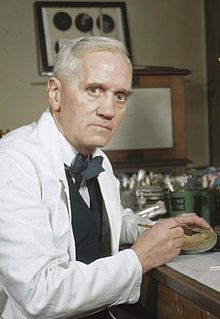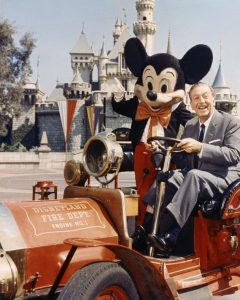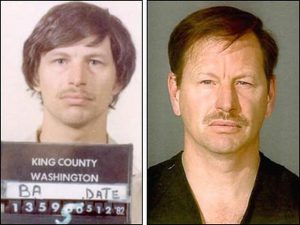People all over the world began calling it a wonder drug. Penicillin. The discovery of penicillin became a gateway for more transformative discoveries. But shockingly, to our surprise, the discovery of such a crucial drug came about from an accident in an experiment in the laboratory of Dr. Alexander Flemming in 1928.
So who was Dr. Alexander Flemming before he became famous for discovering our “wonder drug” penicillin? He was third of the four children descended from lowland farmers in Scotland. Born in 1881, Alexander’s father died when he was at the vulnerable age of seven. He began his educational enlightenment at a moorland school in a small town called Darvel in Scotland, UK.1 Here, twelve students of all ages were taught in a single classroom. Following this, he attended Darvel School, which was a four mile walk for Alexander every school day. After witnessing his potential, he was awarded a two-year scholarship to attend Kilmarnock Academy in Scotland. After those two years, Alexander moved to London where he lived with his older brother Tom. Many of his brothers similarly fled the life of farming to live with Tom. Hugh, the oldest brother, was the only one left to attend the farm.
At the age of twenty, Alexander worked in a shipping office for four years, before he inherited some money from his uncle John Flemming. It was his older brother Tom who encouraged him to follow the same career as him, a physician, and so he did. Excelling academically, it was no surprise he was awarded a scholarship to St. Mary’’s Hospital Medical School in London. Coming from little money, Fleming sought after a brighter future than the one that was waiting for him at the family farm. His decision illustrates the endless possibilities that can come from what a person chooses to make of their situation.
Alexander Flemming was a scientist beginning another one of his multiple research experiments. He was a professor at St. Mary’s hospital, and oversaw a clinic that focused on patients who suffered from boils. Because of all this, he was asked to write on staphylococci, which is a type of bacteria that causes staph infections such as skin infection and blood poisoning. It was 1928, and he began examining the various properties of staphylococcus. Towards the end of July of that year, Flemming was packed up and eager to return home on vacation. He stacked his plates on the lab bench sitting along with many other plates from previous experiments.2 There were plates that were in desperate need to be washed and cleaned up. But Flemming was known for keeping his plates an extended period of time after incubation.
When he returned from his vacation, on Monday, September 3rd, he examined the staphylococci culture plates. Keep in mind that it was unusual to leave culture plates at room temperature. As Fleming was resuming his usual course of action to be taken for such a typical day, he had remarked to Merlin Pryce, his research assistant, that there was a lot of work to be done. He began by taking the top of the culture plate from a stack of several grimy plates; they had some form of biological research left over from earlier experiments. During this time, he came across an unusual plate. Fleming’s response was, “that’s funny,” while Pryce simply brushed it off as one of the plates that helped Fleming discover lyzosome, which was a previous experiment of Fleming’s. To his surprise, the growth of staphylococcus had been diminished, and instead, the mold had grown towards one end of the plate. That is, the bacteria surrounding the mold was being destroyed. The mold had grown on one side of the plate. The shock wasn’t from the presence of mold, which would probable happen in any biological experiment. Rather, it was the complete disappearance of the cultures of staphylococcus. This told him that there was antibacterial substance in the mold that caused the disappearance of staphylococcus. So he decided to make another culture of the mold in a tube of nutrient broth. After a week of being left in the tube, the culture that was diluted about 500 to 800 times had actually inhibited the growth of staphylococci again. After much research, Fleming discovered that this mold belong to the family of penicilliium and was eventually named Penecillium Notatum.3 This was Alexander Fleming’s aha moment, the discovery of penicillin.
Just imagine conducting an experiment for your organic chemistry or biology lab; resuming your usual routine, you’ve come across a potential discovery. Fleming had no intention of achieving such a discovery. In his research he had described it as a “white fluffy mass which rapidly increases in size…cultures darken to almost black.”4 But we have Fleming and his curiosity to thank in this very moment. Just as Pryce had done in that moment, so could Fleming have chosen to ignore the plate and simply wash away the bacteria from the plate. But Fleming instead decided to explore what he saw as curious. It was this very moment that penicillin was discovered. Alexander Fleming was a very disorganized scientist. He was known for leaving his plates all over the bench and his experimental items left in the same place for days before cleaning up. Had he been a more organized scientist in his laboratory, penicillin might never have been discovered. One might say it is because of his untidiness that penicillin had been brought to discovery.5

Thus, the accidental discovery of such a drug sparked positive outcomes for the world in multiple ways. It immediately began saving the lives of hundreds of thousands of people who, prior to 1929, could not be saved with such assurance and ease from their sicknesses. Alexander Fleming was a bright scientist, but that is not to say that his discovery of penicillin was intentional. His messiness and curiosity is what allowed him to come across such a life-changing drug. On another note, discovery of penicillin was just a taste of what the medical science community has been capable of, and it sheds light on how much more there is still to be discovered. Penicillin was not the first and definitely would not be the last accomplishment for American medicine and for the world population.
- Complete Dictionary of Scientific Biography, June 2008, s.v. “Alexander Flemming,” by Charles Gillispie. ↵
- Daniel Schwarz, “The Mold that Fights for the Life of Man,” New York Times, January 2, 1944. ↵
- Daniel Schwarz, “The Mold that Fights for the Life of Man,” New York Times, January 2, 1944. ↵
- F.W.E. Diggins, “The true history of the Discovery of Penicillin, with refutation of the Misinformation in the literature,” British Journal of Biomedical Science 56, no.1 (January 1999): 85. ↵
- F.W.E Diggins, “The true history of the Discovery of Penicillin, with refutation of the Misinformation in the literature,” British Journal of Biomedical Science 56, no.1 (January 1999): 85. ↵



63 comments
Valeria Hernandez
Crystalrose Quintero wrote a fascinating piece on the discovery of penicillin. She provides readers with a wonderful objective and factual information on the story of the medication. I enjoyed reading about the timeline of the medication. A great informative and valid article that provides information on something that is crucial in society as it is antibiotics. Quintero creates a wonderful piece for those interested in pre-health professions.
Rebekah Esquivel
I find it so interesting how often this happens with science. Scientists may not always intend the results they get in an experiment but it may be more worthwhile than they result they were actually intending. This drug was a great discovery and definitely useful in the medical field. I think this article was very interesting and I learned about a pretty interesting story in history.
Richard Navarro
Many amazing things have come from accidents. Its crazy to see how people actually become famous because of it. I believe Coca-Cola was an accident as well. It is funny because we have these neighbors who have their own brewery in their back yard for beer. My dad and I go and taste it all the time and the funny thing is was that his best product was his “bad batch”. Penicillin was use throughout wars and worked wonders. I believe that the name “wonder drug” fits perfectly
Mariah Cavanaugh
Penicillin is a wonder drug that is used to cure everything from pneumonia to ear infections. I am in awe of the fact that the discovery of penicillin was due to the fact that Fleming was essentially a disorganized slob. It is unimaginable to think of the people who would still be suffering if Fleming had simply cleaned up after himself. This was a fantastic article.
Ryann Cervantes
What a fun coincidence about that Saint Mary’s scholarship. Once again another great story about a wonderful invention discovered by accident and even more the fact that his disorganization helped make sure he didn’t lose his discovery. I wonder how many other useful drugs that have changed medicine as much as penicillin have been discovered by accident. Maybe that’s the only way. Also it seems fitting someone who went through as much as he did would make such a discovery. As if his hard work was a needed proof to then be allowed to make the discovery
Luke Willis
This is a very cool article. It is amazing that someone like Alexander was able to make one of the most famous and ground breaking discoveries by simply being an unorganized and messy person. It is amazing that he simply did not ignore the discovery and simply was it away. It is an amazing discovery that has helped millions. I find it kind of interesting because the only thing in the world that I am allergic to is Penicillin. Great Article.
Carlos Aparicio
This article is absolutely mind-blowing! Who knew one of the worlds most advanced medicines in the entire world would be discovered on an accident because of unorganized plates. I really enjoyed the informative part of Mr. Flemming’s biography and how he became to be one of the worlds best scientists. This was a very well-written article with so many details that support the purpose of this reading.
Tara Sellers
It is amazing to think that such a big discovery happened by accident. Not to mention the fact that if he had been organized he would probably not have discovered penicillin. I wonder if accidents like this occur today. We tend to regulate research rigorously so I feel like it is unlikely. This is a well written article and it was interesting.
Rafael Azuaje
In my SMC philosophy class we were discussing how a moment of insight is reached and a difficult problem solved. According to the text we’re using in that class, accidental discoveries like the one in this article don’t entirely happen by chance. The conditions to capitalize on the observation of an unusual mold on one of the culture plates in the lab had to be present as well. As far as discoveries go I’m very interested to see what the future holds.
Alejandra Chavez
Similar to the match and a popular drink named Coca Cola, it seems to be that a lot of inventions came to be by accident. Also quite ironic that he was awarded a scholarship to an institution with the name of Saint Mary’s. I find it to be quite amazing that some of the strongest bacteria that have some of the biggest effects on the human body are derived from molds. This was a well written article with great facts.